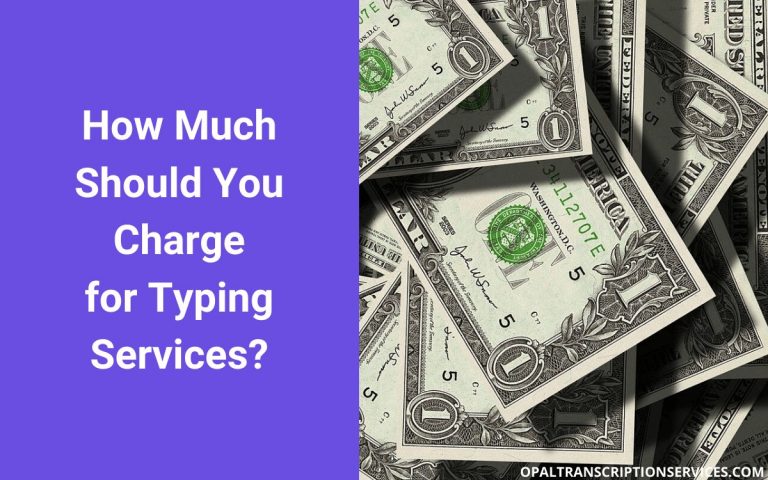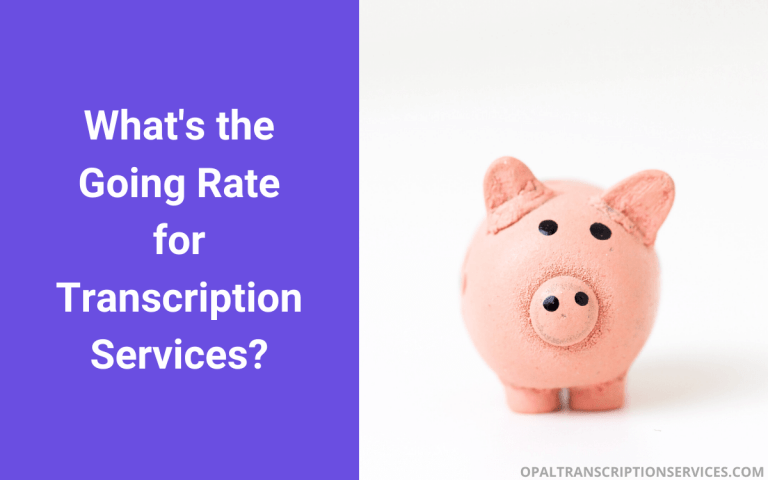How Much Does Transcription Pay? [Salary and Hourly]
How much does transcription pay?
As far as I know, there isn’t a comprehensive resource on the topic, and to some of us it often feels like there’s a mystical shroud surrounding the issue of pay. Hopefully this post will help clarify some things for people who are new to the industry, as well as for experienced transcriptionists wondering what to charge their own clients.
The numbers in this post are ballpark rates based on a mix of research, pay rates cited in online transcription communities, and my own experience.
Here’s what we’ll cover in this post:
- Why transcription pay might be set to increase
- How much do transcriptionists make hourly?
- What is a transcriptionist’s annual salary?
- How much do medical and legal transcriptionists earn?
- Factors affecting transcription pay
- How much does a transcriptionist get paid per audio minute? per line? per page? per word?
- Strategies I’ve used to more than triple my hourly pay
This post may contain affiliate links. See my disclosure for more info.
Why transcription pay might be set to increase
In November 2019, subcontractors of a certain transcription giant took to social media and the press to voice their displeasure over a 30% pay cut that came more or less unannounced. This was the latest in a series of uprisings by gig workers from companies like Instacart, DoorDash, and Uber. A media firestorm ensued, and the curtain was pulled back on an often-exploitative industry.
The result appears to be that potential clients are interested now, more than ever, in partnering with companies that use “ethically sourced transcribers.” This is encouraging news in an industry where pay rates have been dwindling, due in large part to automated transcription platforms and dirt-cheap outsourcing. In honor of the sentiment, I put together a list of transcription companies that pay $1 per audio minute or more, so make sure to bookmark that and check it out when you have a chance.
How much do transcriptionists make hourly?
Professional transcriptionists who work remotely as independent contractors generally earn anywhere between $10-40 USD per hour.
As a transcriptionist based in the U.S. or Canada, an hourly rate of $15-20 USD is a good baseline rate to aim for when working remotely as an independent contractor for a transcription agency. Anywhere between $25-40 USD per hour is a good baseline rate to shoot for when transcribing freelance for private clients.
Note that I’m basing these estimates on pay rates for transcriptionists working with companies that pay at least $1 per audio minute, which is the minimum pay rate recommended by many professional transcriptionists. If you work for an agency that pays 30 cents per audio minute, it’s going to be difficult to attain the above hourly rates.
What is a transcriptionist’s salary?
If we do the math using the hourly rate estimates above, the annual salary for a full-time freelance transcriptionist, roughly speaking, ranges from $20,800-$83,200.
If you start your own transcription or virtual assistant service, you can outsource some or all the work and scale your hourly and annual pay.
How much do legal transcriptionists make?
The BLS doesn’t track data specifically for legal transcriptionists, but puts the median annual pay for court reporters at $57,150 per year, or $27.48 per hour.
ZipRecruiter reports salaries ranging from $14,500-130,000 for work-from-home legal transcriptionists, with an average annual salary of $55,869.
How much do medical transcriptionists make?
According to the Bureau of Labor Statistics, the median pay for a medical transcriptionist is $34,770 per year, or $16.72 per hour.
ZipRecruiter reports annual salaries for work-from-home medical transcriptionists ranging from $16,000 to $120,500 per year, with the average annual pay at $49,746.
P.S. If you’re an independent medical transcriptionist earning $120,500 per year working for MTSOs, please get in touch with me – I have questions! 😉 The above estimates should be taken with a grain of salt.
Note that medical and legal transcriptionists may also work as employees in a medical or legal office, and the wages and salaries for those positions will be different than those cited above.
Factors that affect transcription pay
Your hourly pay as a transcriptionist will depend on several things:
The transcription company you work for. To reiterate, $1 per audio minute is considered by many professional transcriptionists to be an acceptable baseline pay rate when working for a transcription agency. (If you have your own clients, you can charge more.) In my directory of 75+ online transcription services, I’ve included info on company pay rates wherever possible. Transcriptionists with training and experience will qualify for more and higher-paying opportunities, such as legal transcription. If you’re interested in studying transcription online, I recommend the Transcribe Anywhere courses.
Your typing speed. Most professional transcriptionists can transcribe one hour of clear one- or two-speaker audio in roughly four hours or less. If you’re being paid $1 per audio minute and we apply this 4:1 transcription-time-to-audio ratio, it works out to an hourly pay rate of $15 per hour. If you increase your productivity to a 2:1 or 3:1 ratio (totally possible), you can earn $20-30 per hour for that same $1-per-audio-minute rate. Keep reading for strategies I’ve used to almost double my transcription productivity and at least 3X my hourly pay.
Audio difficulty. Apart from your typing speed, there are several other factors that will affect your transcription time, including audio quality, number of speakers, and the amount of research involved. Some companies charge clients more (and pay transcriptionists more) for challenging audio.
Whether you work for an agency or your own clients. When you cut out the middleman (the transcription agency) and source your own clients, you can really skyrocket your pay, because you can charge the full amount that an agency would charge. As an independent contractor, you’re free to do both things – work for private clients and hang onto your agency contracts as backup work.
How does a transcriptionist get paid?
Work-at-home transcriptionists are usually hired as independent contractors. This means they’re actually small business owners or freelancers rather than employees and are usually paid on production (per piece rather than per hour).
In other words, the more efficient you are, the more you’ll earn. Notice I didn’t say “the faster you can type, the more you’ll earn.” While this may be true, there are a lot of ways to boost your transcription productivity besides increasing your typing speed in words per minute. I’ll cover those in the next section.
Transcriptionists are typically paid in one of the following ways:
- Per audio minute. This is the most common pricing structure in general transcription and is often used in legal transcription as well. Transcription agencies typically charge $1.50-$5 USD per audio minute. Remote staff are often paid 50-75% of this. As noted above, $1 per audio minute is seen by many transcriptionists as a minimum acceptable pay rate for subcontractors.
- Per line. This is the most common pricing structure in medical transcription. Clients are typically billed 7-14 cents per line, and remote staff receive a percentage of this. Common pay rates for VR editing are 3-5 cpl (cents per line).
- Per page. Common in legal transcription and copy typing. I’ve seen legal transcription companies paying remote staff anywhere from $0.75-$1.75 per page, with $1.25 per page seen as an acceptable starting point. For copy typing services (i.e., text-to-text transcription), agencies may charge from $4-15 per page, depending on the legibility and complexity of source material as well as turnaround time, with typists receiving a percentage of this rate.
- Per word. Also commonly used in legal transcription and copy typing. Common per-word rates for legal transcriptionists working remotely for transcription companies range from $0.0025-$0.005 per word (i.e., a quarter- to a half-cent per word). This works out to $0.88-$1.75 per 350 words (an approximate page length).
How to increase your transcription pay
As a transcriptionist working as an independent contractor, your hourly earnings are dependent on 1) how fast you can work and 2) your per-piece rate.
There’s a lot you can do to influence both these factors and optimize your effective hourly rate. Below, I’ve included some of the tips I’ve used to multiply the hourly rate I started out with.
Work for higher-paying transcription companies
Just because you’ve been hired by a transcription company with a decent amount of work doesn’t mean you should get complacent and stop your job search there. You could be missing out on far better opportunities.
The secret to continually improving your rates as a professional transcriptionist is to keep applying to transcription companies, even when you have enough work. As you gain higher-paying contracts, you can quit the lower-paying ones or keep them on as backup gigs for when your best contracts are low on work. This way, you can continue to optimize your hourly pay and ensure you always have work available.
A lot of people think companies like Rev and TranscribeMe are the only work-from-home transcription gigs out there, but the truth is there are hundreds of transcription companies that hire remote workers, many of them paying more than 50 cents per audio minute. Start with my list of 75+ transcription jobs – where possible, I’ve included information on the company’s pay rates and whether they hire worldwide. (For advanced tips on finding even more transcription gigs, see my post on how to become a work-from-home transcriptionist.)
Many of the companies in my 75+ list, including most of the legal transcription companies, require transcription experience, training, or certification. As a student of Janet Shaughnessy’s online transcription school, I recommend her training programs in general and legal transcription. She also teaches how to market yourself as a transcriptionist and find work.
Double your transcription pay with private clients
By finding your own clients and charging your own rates, you can cut out the middleman (transcription agencies) and earn a lot more. Transcription agencies often charge clients twice as much as they pay their ICs. This means you could easily charge clients twice what your agency contracts are paying you and earn at least twice as much as per hour. You can also be selective about who you work with and the types of jobs you take on, increasing your hourly pay even more.
If you work for private clients, I don’t recommend charging less than $1 USD per audio minute, and that’s low. Good clients are happy to pay professional rates for high-quality work that they don’t have to edit afterward.
The nice thing is that as an independent contractor, you can market for your own clients and keep your contracts with transcription companies as backup gigs.
Get the right equipment
If you’re not already using digital transcription software and a foot pedal, you’re missing out big-time: These tools are super easy to use and can 1.5-2X your transcribing speed from the moment you start using them. That’s essentially doubling your hourly pay in an instant!
You can use the free version of Express Scribe transcription software with hotkeys to control audio playback. For best results, I recommend connecting a foot pedal compatible with Express Scribe to control audio playback instead of using your fingers. I like the Infinity USB pedal because it’s ergonomic, easy to install, and compatible with most software that transcription companies use.
You’ll also need a quality transcription headset to help you transcribe challenging files more easily. Some transcription headsets, such as the Spectra and the WordMaster headsets, have built-in sound cards designed to match the frequency of the spoken word or make low-quality audio clearer and louder.
Learn speed typing
Many of us learned to type the wrong way, myself included. With bad typing habits, it’s difficult to reach professional typing speeds of 50-80+ wpm without the help of text expander software.
The good news is you can relearn typing the right way and get up to speed with consistent practice.
The following resources will help you do that:
- Touch Typing Mastery – Learn to type correctly. This bestselling course on Udemy teaches you how to touch type and improve your WPM count in 12 easy lessons, and it’s a lot more affordable than taking a traditional typing class.
- KeyBlaze Typing Tutor. This software from the makers of Express Scribe transcription software includes typing exercises and games, as well as dictations for transcription practice. You can also set personal wpm speed targets to hold yourself accountable. You can download the free version of Keyblaze here.
Use text expander software
Professional medical and legal transcriptionists often use text expander software to reduce their transcription time by an average of 30%.
Text expander tools lets you create custom text shortcuts, which are automatically expanded as you type. For example, you could type “wr” and have it expand to “whatever” when you press space or tab. You can also expand entire phrases, such as “tym” to “thank you very much.” Use a logical abbreviation system like the ABCZ method for creating shortcuts that you’ll remember.
FastFox is a text expansion tool by the makers of Express Scribe free transcription software. Besides letting you enter custom shortcuts, FastFox also pays attention to phrases you commonly use and suggests them to you as you type. You can then double-click the control key and the program will expand the phrase for you. This “smart” feature means you can use the software without spending a lot of time setting up your own keyboard shortcuts and macros.
Go here to download the free trial of FastFox and find out how much faster you can transcribe with the magic of text expansion!
Improve your punctuation skills
A skilled transcriptionist is an editor first and a typist second.
A lack of attention to punctuation is one of the most common problems I see in this industry – not just in transcripts, but also in cover letters and resumes. Don’t scare potential employers away: By brushing up on your grammar and punctuation, you can really set yourself apart as a transcriptionist and land more and higher-paying contracts.
You can get better at grammar and punctuation, and you can do so in a surprisingly short amount of time. My favorite books on the subject are:
- Grammar Girl Presents the Ultimate Writing Guide for Students
- The Best Punctuation Book, Period
- The Quotable Guide to Punctuation
Try voice recognition software
If you’re not the fastest typist in the world or you’re prone to repetitive stress injuries (both true in my case), consider “echo dictating” your transcripts using speech recognition software. I’ve been using Dragon to re-dictate my transcripts for years – not only has it put a stop to my hand pain, but it’s also resulted in a boost in my transcription pay.
You can purchase and download the latest version of Dragon directly from Nuance’s website. Or, you can get an older and less pricey boxed version on Amazon (I’ve used this version and it works fine).
To echo dictate, you’ll need to swap your current headset for one with a mic. I currently use the Logitech H390 ClearChat headset, an affordable USB headset with a noise-canceling mic and inline volume control.
Note that Dragon won’t work with the software used by some transcription companies (medical transcription companies in particular). I use it with Office 365, which includes the latest version of Microsoft Word, and it works great. If you work for a company that lets you type your transcripts directly into Microsoft Word before pasting them into the company’s own transcription platform, you should be fine to use it.
Your turn
I hope this post was helpful. You can help me make it better for everyone – if you’d like to report what you earn as a transcriptionist (without breaking any NDAs) or what you charge your clients, leave a comment.
Also, feel free to share your best tips for working faster and boosting your transcription pay rate. I know some of you out there are transcription speed demons. We can all help each other out.
If you enjoyed this post, don’t forget to share it!







Hi Chloe,
Thank you so much for sharing the information about voice recognition software! I would also be grateful to learn more tips from all of you wonderful “transcription speed demons”.
Val,
I’m glad you found it useful! I just love my Dragon software — I wouldn’t be able to do this work without it. 🙂
Chloe
I’m so glad I found your post. I’m trying to get a friend “up to snuff” as a beginner legal transcriptionist and trying to explain the different payment methods had me stuck. I only worked for one law enforcement transcriptionist company who paid per audio minute, and I wasn’t fully versed in the other payment methods. I’ll forward her your post which should give her the info she needs. It’s also given me needed info about current rates. I’ve been away from transcription work for a couple of years but intend to get back into it after a needed surgery on my left hand. Many thanks.
You’re very welcome, Janet! Thanks so much for reading and commenting, and all the best as you get back into transcription work!
Thanks for the great information. Quick question: Can you use Dragon while simultaneously playing transcription audio in the background? I know Google drive also has a dictate feature, but you can’t use it while playing audio in the background.
Hi Bee!
Yes, absolutely — you can use Dragon to type into Word while simultaneously playing back the audio in your transcription software. It’s a good little system. 🙂 Thanks for your question!